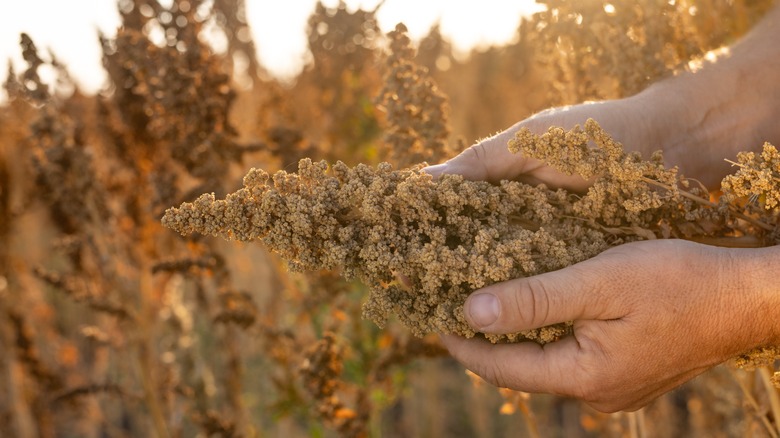What You Need To Know About Quinoa Before Eating It On A Gluten-Free Diet
We may receive a commission on purchases made from links.
Quinoa is a popular type of grain flush with beneficial ingredients such as fiber, antioxidants, folate, protein, and zinc. Widely considered a superfood, quinoa exploded in popularity because of its versatility, easy cooking, and nutrient-dense properties. Another reason people love quinoa is because it's gluten free, making it a more inclusive dish for gluten-intolerant friends and family members. However, those with extreme gluten sensitivities should be more cautious when cooking and eating quinoa because it's considered a high-risk ingredient.
This just means that, while quinoa itself does not contain gluten proteins, it is often harvested and processed with wheat, barley, and rye – and all three of these grains are major offenders when it comes to gluten. So, when harvested together, cross-contact can occur, which means the quinoa is potentially exposed to gluten. This makes it no longer safe for people with extreme intolerances or celiac disease to consume. Cross-contact can also happen when quinoa is made with gluten-containing ingredients like bouillon cubes, or cooked in unwashed dishware previously used to make or heat up something with gluten in it.
How to ensure quinoa is actually gluten free
The good news is that not all quinoa is harvested with gluten-containing grains. When shopping for quinoa, it's important to check the packaging for a "gluten free" label. In order to qualify for this label, the U.S. Food and Drug Administration (FDA) states that the product must contain less than 20 parts per million (ppm) of gluten in the food. It's also important to look at the ingredients list, because certain food additives contain hidden gluten. Most of the time, you'll see a warning note that says "Contains wheat, soy, milk, and egg ingredients," which is a good indication that gluten may be present.
For example, this organic quinoa by Better Body Foods on Amazon checks all the boxes. It's also a good practice to skip the bulk bins altogether, because those are hotbeds of cross-contamination. Unfortunately, when you're out to eat at a restaurant, there's no guarantee that the quinoa dishes you order are completely gluten free. Always do your due diligence and ask how the quinoa is prepared, as this can help ensure that you don't unintentionally ingest gluten. When asking about preparation, check to see if the restaurant cooks its quinoa in water or chicken broth or stock (which can sometimes contain gluten).

